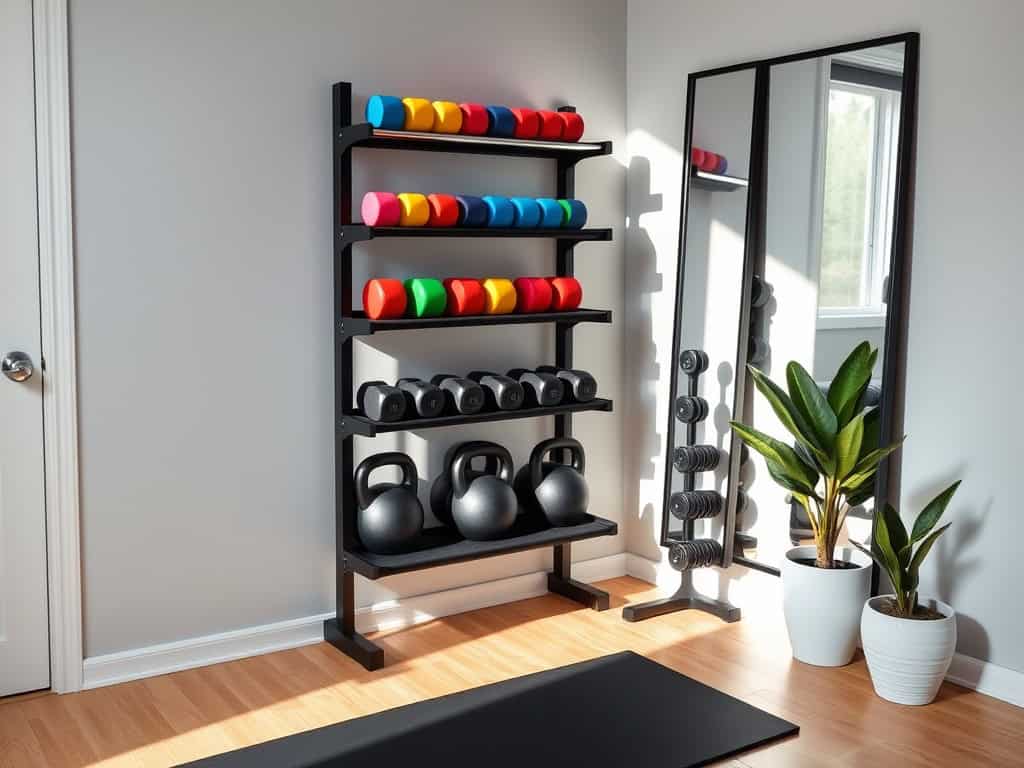You’ve invested in quality weights for your home gym, but now they’re scattered across the floor like forgotten toys. Trust me, I’ve been there! Having the right storage solutions not only keeps your space organized but also prevents injuries and extends the life of your equipment. From wall-mounted racks that maximize vertical space to clever corner units that transform dead zones into functional storage, these seven game-changing solutions will revolutionize your workout area. Let’s explore how to turn your cluttered gym into an efficient fitness sanctuary.
Wall-Mounted Weight Racks: Space-Saving Vertical Storage
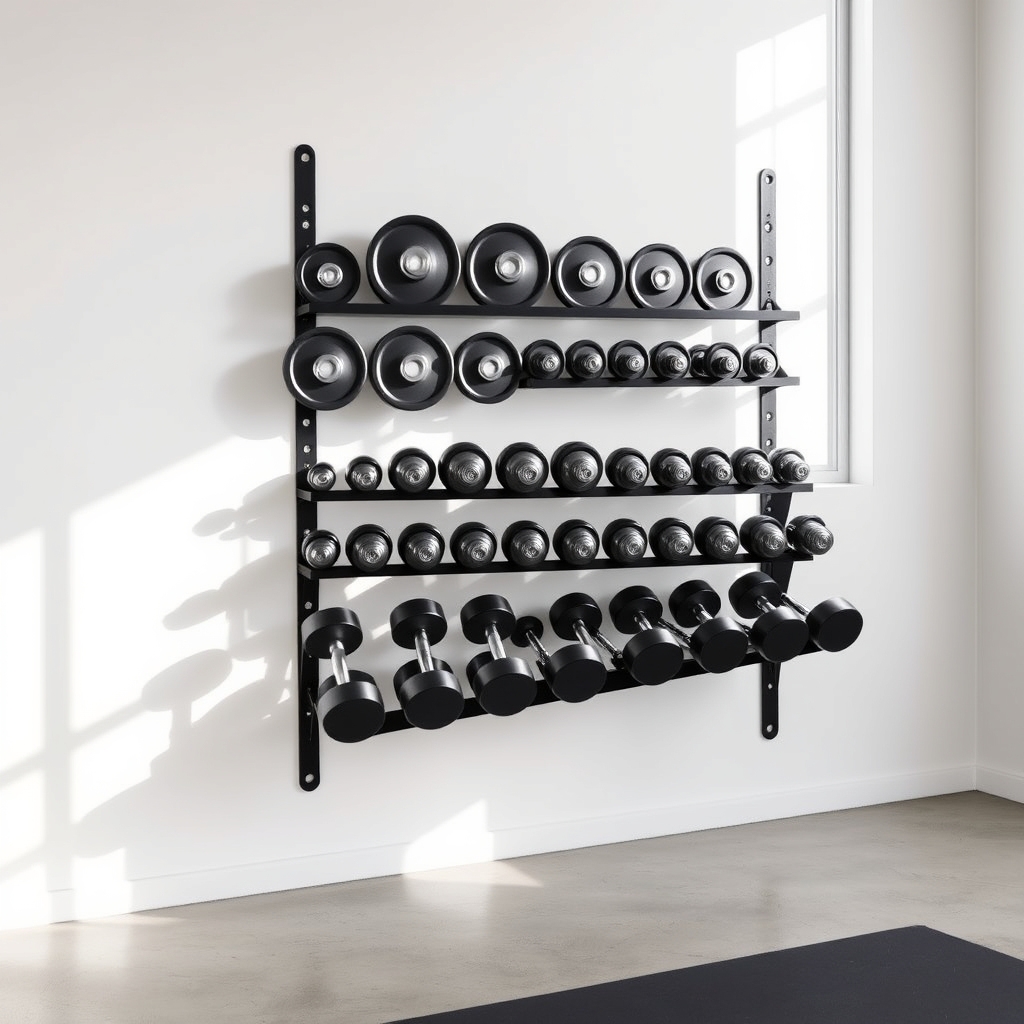
Proper organization of wall-mounted weight racks is crucial for maintaining a safe and efficient home gym environment. Vertical storage maximizes floor space while keeping weights easily accessible, preventing potential tripping hazards and reducing the risk of injury during workouts.
Wall-mounted storage systems not only protect your investment in weight equipment but also create an aesthetically pleasing workout space that motivates consistent exercise. When weights are properly organized on sturdy wall mounts, you can quickly identify and access the desired weight plates or dumbbells, streamlining your workout transitions and maintaining proper form.
Required Items:
- Wall-mounted weight rack system
- Wall stud finder
- Level
- Drill and drill bits
- Mounting hardware (screws, anchors)
- Measuring tape
- Pencil
- Socket wrench set
- Safety equipment (goggles, work gloves)
Installation and organization begins with locating wall studs using a stud finder and marking their positions clearly. Measure and mark the desired height for the rack, ensuring it’s at a comfortable level for accessing weights while considering ceiling clearance.
Mount the rack securely using appropriate hardware, testing each connection point for stability. Arrange weights in ascending order, with heavier plates at bottom levels and lighter ones at top levels for safety and balance distribution.
For weight plate storage, organize plates by size with the largest diameter plates closest to the wall, creating a cascading effect that makes it easy to access any size. If storing dumbbells, arrange them in pairs from lightest to heaviest, leaving adequate space between pairs to prevent contact damage.
Ensure all weight storage posts or pegs are rated for the weight they’ll hold.
Additional organization tips: Apply weight identification labels or markers for quick reference, especially in low-light conditions. Install rubber backing or wall protectors behind the rack to prevent wall damage from accidental contact.
Regularly inspect mounting hardware and tighten as needed, particularly if you notice any wobbling or unusual movement during weight removal or replacement.
Multi-Tier Dumbbell Storage Trees
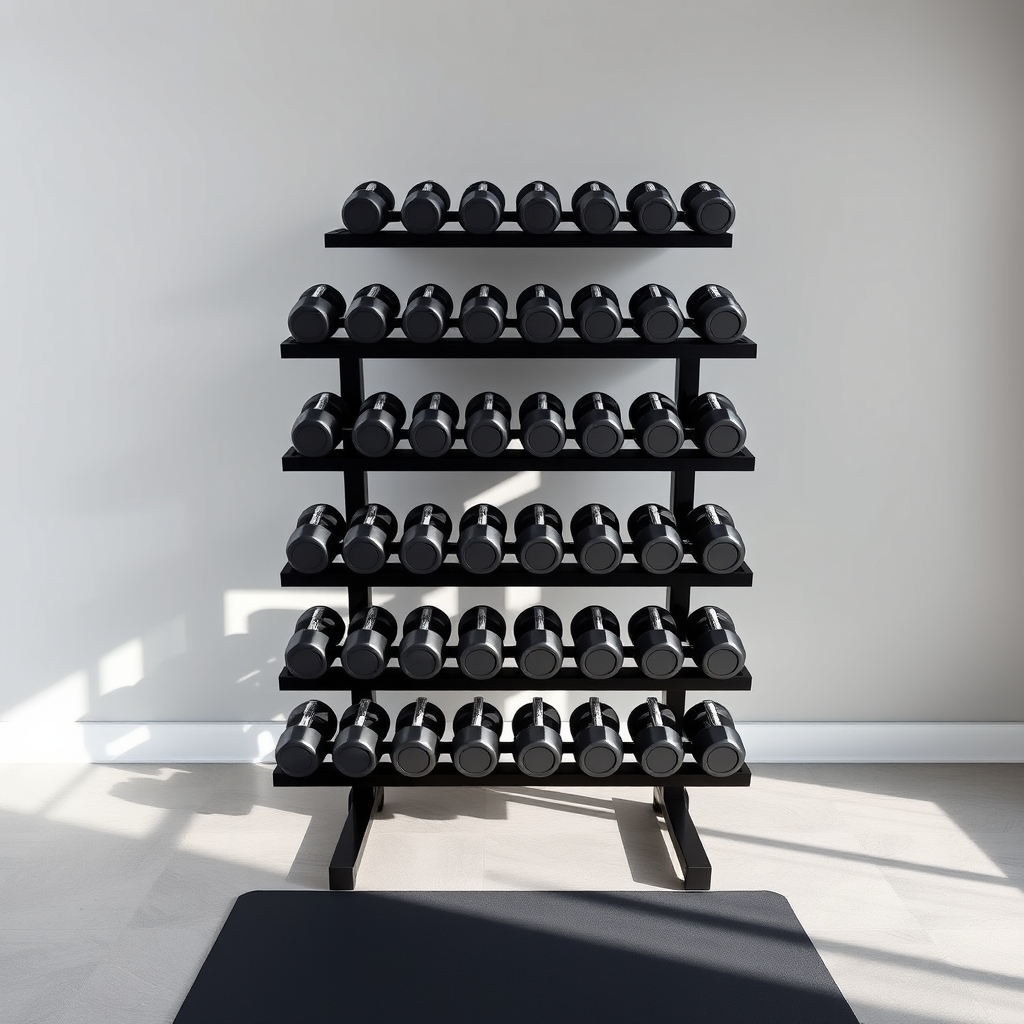
Proper organization of dumbbells in a home gym setting is crucial for both safety and efficiency. A well-organized dumbbell storage system prevents tripping hazards, reduces the risk of injury, and makes workouts more fluid by eliminating time spent searching for matching pairs.
Multi-tier dumbbell storage trees are an excellent space-saving solution that can accommodate various weight ranges while keeping your equipment easily accessible. These vertical storage systems maximize floor space usage and create an aesthetically pleasing display that can motivate you to maintain an organized workout environment.
Required Items:
- Multi-tier dumbbell storage tree
- Measuring tape
- Level
- Assembly tools (typically included)
- Floor protection mat
- Cable ties or straps (optional)
- Weight labels (optional)
- Cleaning supplies
Assembly and organization of a multi-tier dumbbell tree requires careful planning and execution. Start by placing the storage tree in a location that provides easy access from all sides, preferably against a wall for stability.
Arrange dumbbells with the heaviest weights on the bottom tiers to maintain a low center of gravity and prevent tipping. Organize matching pairs on the same level, typically progressing from heaviest to lightest as you move up the tiers.
When loading the tree, ensure even weight distribution on both sides. Position dumbbells with handles facing outward for easy gripping, and maintain consistent spacing between pairs. If your storage tree features adjustable tiers, customize the spacing to accommodate different dumbbell sizes efficiently.
For optimal organization and longevity of your storage system, regularly inspect the tree’s stability, tighten any loose connections, and clean both the rack and dumbbells.
Consider adding weight labels to each tier for quick identification, and use rubber matting underneath to protect your floor and reduce noise. Implementing a “replace after use” policy will help maintain organization and prevent weights from being left around the workout area.
Corner Weight Storage Units for Tight Spaces
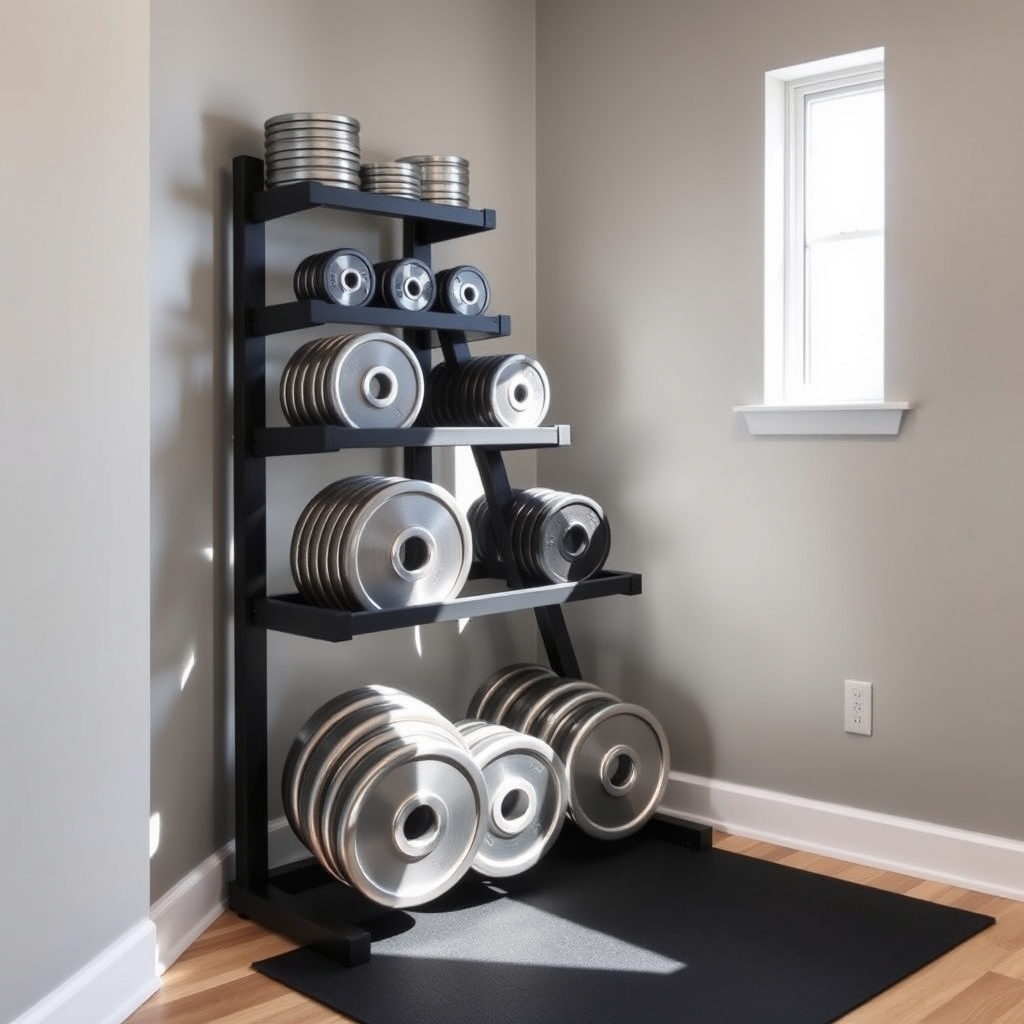
Making the most of corner spaces in a home gym is crucial for maximizing limited square footage while maintaining easy access to weights and equipment. A well-organized corner weight storage system not only prevents weights from becoming tripping hazards but also helps protect walls and flooring from damage caused by improper storage.
Corner storage solutions are particularly effective because they transform often-underutilized spaces into functional storage areas. By implementing vertical storage methods and utilizing corner-specific organizational tools, you can create an efficient system that keeps weights accessible while maintaining a clean, professional appearance in your home gym.
Required Items:
- Corner weight tree or rack
- Anti-slip rubber matting
- Wall anchors and mounting hardware
- Measuring tape
- Level
- Drill and drill bits
- Corner bumper guards
- Weight collars or clips
- Storage bins for small items
- Label maker
Begin by measuring your corner space and clearing the area completely. Install rubber matting to protect your flooring, extending it at least 12 inches beyond where the weight storage unit will sit.
Mount your corner weight tree or rack according to manufacturer specifications, ensuring it’s properly anchored to both walls for maximum stability. If using a free-standing unit, position it precisely in the corner and use mounting brackets if provided.
Organize weights by type and size, placing the heaviest plates at the bottom for stability. Position frequently used weights at waist height for easy access, while less commonly used items can go higher or lower.
If your storage solution includes multiple tiers or pegs, consider implementing a logical system where weights increase as you move from top to bottom or left to right.
For optimal organization and safety, label each storage position clearly, install bumper guards to protect walls, and maintain clear pathways around the storage area.
Consider adding small storage bins or hooks for weight clips, collars, and other accessories. Regular maintenance checks of mounting hardware and weight organization will ensure your corner storage solution remains effective and safe for long-term use.
Rolling Storage Carts for Flexible Organization
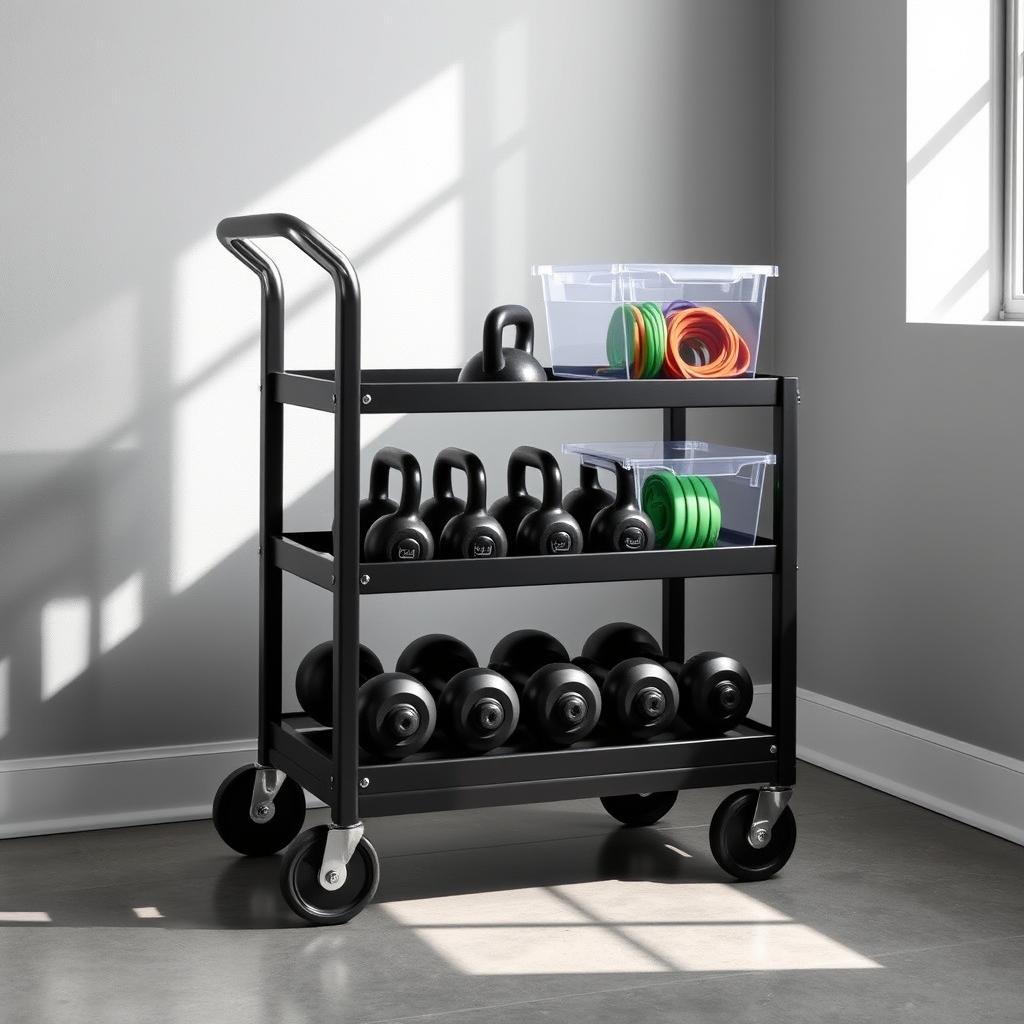
A well-organized home gym storage system is essential for maintaining an efficient workout space and protecting your investment in fitness equipment. Rolling storage carts offer a versatile solution that combines accessibility with mobility, allowing you to reconfigure your workout area as needed while keeping weights and accessories neatly arranged.
Rolling storage carts provide the unique advantage of being able to move heavy equipment without strain, while also maximizing vertical space in compact home gyms. Their modular nature allows for customization based on the types of weights and equipment you own, from dumbbells and kettlebells to resistance bands and medicine balls.
Required Items:
- Heavy-duty rolling cart with weight capacity appropriate for your equipment
- Rubber mat or liner for cart shelves
- Bungee cords or straps
- Label maker or markers
- Measuring tape
- Storage bins or containers
- Shelf dividers
- Assembly tools (screwdriver, wrench)
Assembly and organization begins with selecting an appropriate location for your cart that allows easy access during workouts while maintaining clear pathways. Place the rubber mat on each shelf to prevent sliding and protect both the equipment and cart surfaces.
Arrange heavier items on lower shelves for stability, with frequently used weights at waist height for optimal accessibility. Group similar equipment together, using shelf dividers to create designated spaces for different weight increments or types of equipment.
For enhanced organization, implement a labeling system that clearly identifies weight ranges or equipment types on each shelf. Secure items that might roll with bungee cords or straps, particularly for shelves containing dumbbells or kettlebells.
Consider using storage bins on upper shelves for smaller items like resistance bands, gloves, or workout accessories.
Additional Tips: Regularly inspect the cart’s wheels and locking mechanisms to ensure safe movement and stability. Clean and maintain both the cart and equipment regularly to prevent rust and wear.
Consider implementing a “return to home” position for the cart after workouts to maintain consistent organization and maximize floor space when not in use. Keep a small margin of extra space on each shelf to accommodate future equipment additions without requiring a complete reorganization.
Horizontal Weight Plate Storage Solutions

Proper storage of weight plates is crucial for maintaining an organized and safe home gym environment. When plates are scattered or improperly stored, they not only create tripping hazards but also make workouts less efficient as you waste time searching for matching weights.
Horizontal storage solutions are particularly effective for home gyms, as they maximize floor space while keeping weights easily accessible.
Horizontal weight plate storage offers several advantages over vertical storage, including reduced strain on walls and floors, better weight distribution, and easier identification of plate sizes. This storage method also helps prevent plates from falling or rolling, making it an ideal solution for both safety and convenience.
Required Items:
- Weight plate storage rack or tree
- Measuring tape
- Level
- Mounting hardware (if wall-mounted)
- Rubber mat or padding
- Weight collar stops
- Labels or markers
- Cleaning supplies
Begin by selecting an appropriate location for your horizontal weight storage system, ensuring there’s adequate clearance for both the storage unit and easy access to the plates.
For wall-mounted solutions, locate wall studs and secure the rack firmly using appropriate mounting hardware. For freestanding units, place them on level ground, preferably on rubber matting to protect your floor.
Organize plates by size, with the heaviest plates closest to the ground for stability. Arrange matching pairs on the same pegs or sections to streamline your workout process.
Ensure all storage posts have weight collar stops installed to prevent plates from sliding off. Clean each plate before placing it on the rack, and consider adding weight indicators or labels for quick identification.
For optimal organization and longevity of your storage system, regularly inspect mounting hardware and weight posts for signs of wear. Implement a “replace as you use” policy to maintain organization, and consider adding rubber bumpers between plates to prevent metal-on-metal contact and reduce noise.
Keep frequently used plates at waist height for easy access, and always maintain clear walking paths around your storage area.
Under-Bench Storage Systems
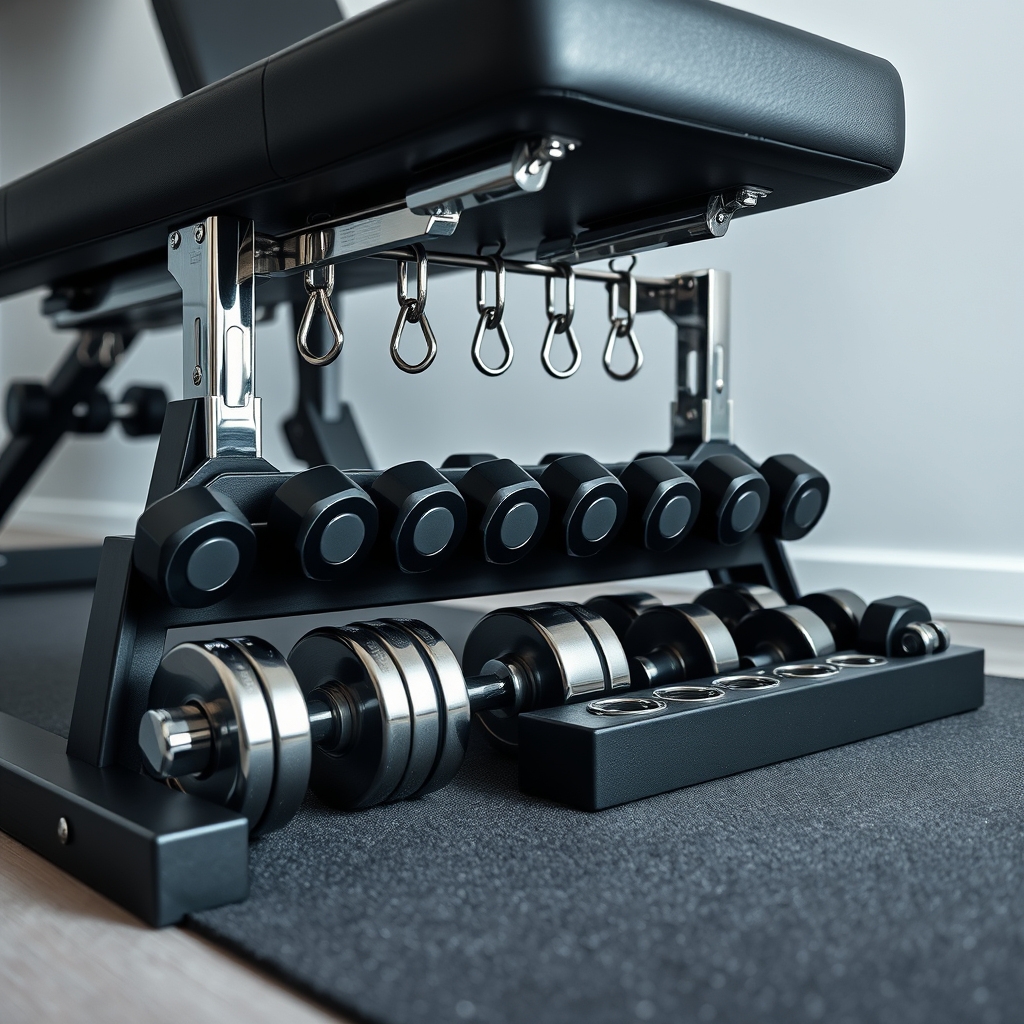
Efficient under-bench storage is crucial for any home gym setup, maximizing the use of often-overlooked space while keeping weights easily accessible during workouts. A well-organized under-bench storage system not only prevents tripping hazards but also protects your weights from damage and maintains the professional appearance of your workout space.
Proper organization of weights under your bench creates a seamless workout experience, allowing quick weight changes during supersets or circuit training. This storage solution is particularly valuable for those with limited space, as it utilizes the footprint you already have dedicated to your weight bench.
Required Items:
- Weight storage hooks or brackets
- Mounting hardware (screws, anchors)
- Measuring tape
- Level
- Drill
- Screwdriver
- Storage bins or trays
- Weight collars organizer
- Cable ties or straps
- Rubber matting
The organization process starts with measuring the available space under your bench and planning the layout. Install weight storage hooks or brackets on both sides of the bench, ensuring they’re properly secured and evenly spaced.
Place heavier weights closer to the ground for stability, with lighter weights and accessories positioned for easy access. Consider installing a sliding tray system for smaller items like weight collars and resistance bands.
For maximum stability and protection, lay rubber matting underneath the entire storage area. Arrange dumbbells and weight plates in ascending order, with the most frequently used weights positioned at the optimal reaching distance.
Implement a small-to-large organization system, moving from front to back, which makes it easier to locate specific weights quickly during workouts.
Additional Tips: Consider adding labels or weight indicators for quick identification, and install safety stops to prevent weights from rolling out. Regular maintenance of the storage system, including tightening brackets and checking weight positions, will ensure long-term durability and safety.
Clean the area beneath the bench regularly to prevent dust accumulation and maintain proper equipment condition.
Modular Storage Cubes and Shelving Units
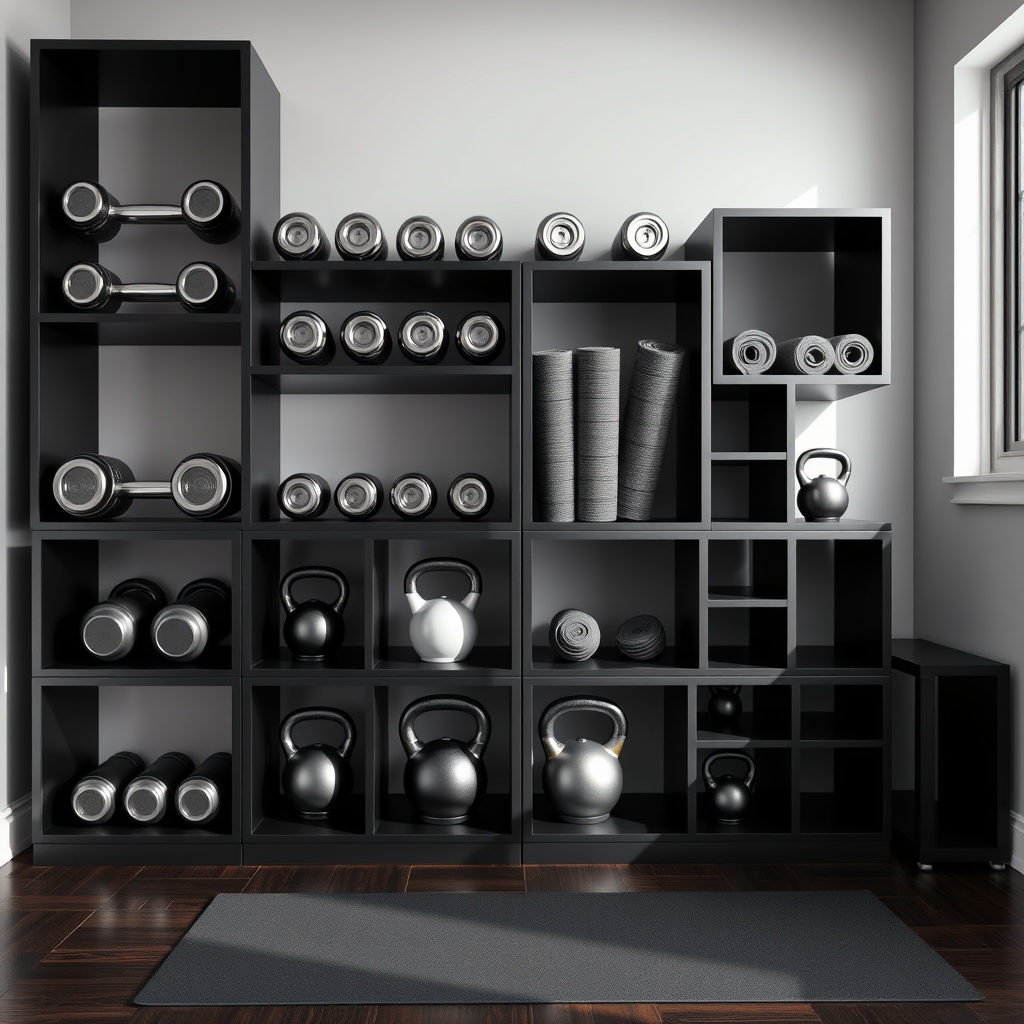
Proper organization of modular storage cubes and shelving units in a home gym is crucial for maximizing space efficiency and ensuring easy access to weights and equipment. A well-organized storage system not only creates a safer workout environment but also helps protect your investment in fitness equipment by preventing damage from improper storage.
Modular systems offer the flexibility to customize your storage solution based on your specific needs and available space. These versatile units can be reconfigured as your equipment collection grows or changes, making them an ideal choice for evolving home gym setups.
Required Items:
- Modular storage cubes
- Heavy-duty shelving units
- Assembly tools (screwdriver, Allen wrench)
- Level
- Measuring tape
- Wall anchors
- Cable ties or straps
- Non-slip shelf liners
- Labels or markers
- Safety gloves
Start by measuring your available wall space and planning the layout of your modular system. Position heavier items on lower shelves for stability and safety, while keeping frequently used weights at arm level. Assemble the base units according to manufacturer specifications, ensuring they’re properly leveled and secured to the wall using appropriate anchors.
Configure the cubes in a pattern that accommodates your specific equipment sizes, creating designated zones for different weight categories. For optimal organization, sort weights by type and size, placing dumbbells in graduated order within easy reach. Utilize vertical space by stacking compatible cubes, but maintain proper weight distribution.
Install non-slip liners on shelves to prevent equipment from sliding and reduce noise. Create clear pathways between storage units to allow easy access during workouts.
Additional Tips:
Leave room for future expansion when planning your initial setup. Label shelves clearly to maintain organization over time, and regularly inspect the units for stability and wear. Consider adding LED strip lighting to improve visibility in storage areas, and implement a “return to home” policy after each use to maintain organization.
Periodically reassess your storage needs and adjust the configuration as your fitness equipment collection evolves.

